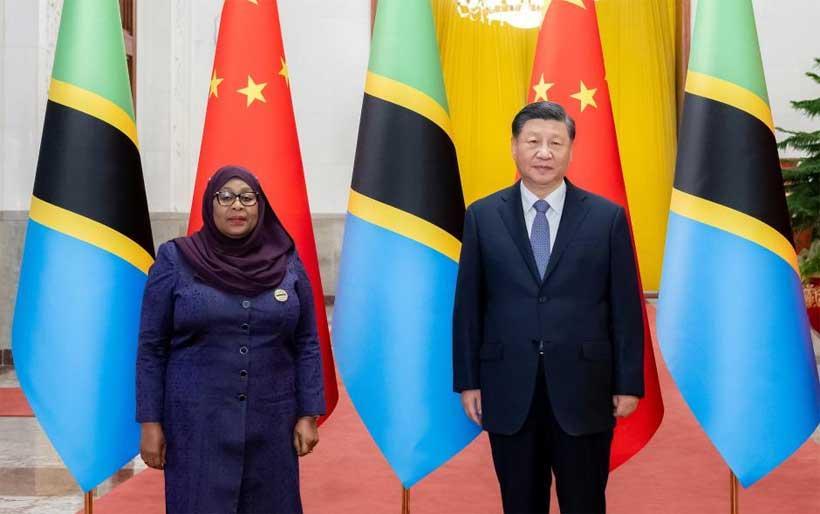By
Rashidi M. Makwega
Africa-Press – Tanzania. In recent decades, the partnership between the United Republic of Tanzania and the People’s Republic of China has strengthened remarkably. Through trade agreements, development aid, and direct investment, China has emerged as a key stakeholder in Tanzania’s infrastructure development. This partnership is evident through the implementation of major strategic projects aimed at propelling Tanzania toward a modern economy. Improved infrastructure has become a major catalyst for domestic and foreign investment, job creation for Tanzanians, and technology transfer from China. This article thoroughly analyzes how Chinese projects contribute to laying the foundation of a modern economy in Tanzania.
Transformative Strategic Projects, One of the largest Chinese projects in Tanzania is the construction of the Standard Gauge Railway (SGR). Sections five (Isaka–Mwanza) and six (Tabora–Kigoma) are being constructed by China Civil Engineering Construction Corporation (CCECC) and China Railway Construction Corporation (CRCC). This railway aims to connect Tanzania with neighboring countries such as Burundi, Rwanda, and the Democratic Republic of Congo, positioning Tanzania as a trade hub in East Africa. Besides boosting trade, the SGR has created thousands of temporary jobs for Tanzanians in construction, engineering, and other services.
Another key project is the Sapphire Float Glass factory located in Mkuranga, Coast Region, established by Chinese investors in 2023. The factory produces modern glass for domestic use and export to neighboring countries, providing over 1,000 direct jobs to Tanzanians. It also reduces the need for imported glass and supports the growth of the construction and industrial sectors.
In the sports sector, China, through the CRCEG Company, is constructing the Samia Suluhu Hassan Stadium in Arusha. This project is part of preparations for Tanzania to host the 2027 Africa Cup of Nations. Beyond sports development, the project creates jobs and transforms entertainment, tourism, and sports infrastructure.
In the energy sector, China Gezhouba Group, in collaboration with TANESCO, is implementing the Rumakali Hydropower Project in Njombe Region. This project is expected to generate 222 megawatts and contribute over 2,400 GWh annually to the national grid. Reliable energy will strengthen industrial investment and enhance local production.
Wider Impacts on Investment and Employment, One of the major benefits of Chinese projects is improved infrastructure, which now attracts both local and foreign investors. Projects such as the SGR, Dar es Salaam Port, and the Rumakali power project facilitate transportation, distribution of goods, and energy supply, thereby reducing business costs. Companies from Europe, Asia, and the Middle East have already shown interest in investing in Tanzania due to this enabling environment.
Moreover, areas like Mkuranga, Kibaha, and Morogoro have witnessed rapid urban and industrial growth due to Chinese projects. These areas have seen population increases and improvements in social services, housing, schools, hospitals, and markets—signs of urban development and improved livelihoods.
In terms of employment, Chinese projects have significantly helped reduce unemployment, especially among youth. During construction, many temporary jobs are created for technicians, laborers, and professionals. After construction, permanent employment opportunities are offered in factories, administration, transport, and services.
Technology and Skills Transfer, The collaboration between China and Tanzania has also led to the transfer of technology through on-the-job training. Many Chinese companies bring in experts who train Tanzanians, resulting in a skilled local workforce. Additionally, the Chinese government has provided scholarships for Tanzanian students to study in fields like engineering, technology, business, and agriculture in China.
Agricultural Transformation and Agribusiness, as part of building a modern economy, agriculture continues to be a vital pillar receiving renewed momentum through China-Tanzania cooperation. These transformations are evident not only in increased production but also in the transition of agriculture from subsistence to a major source of business, employment, and industrial raw materials.
China has been a major partner in helping Tanzania modernizes agriculture in several ways. First, through agricultural research projects, experts from both countries have collaborated to develop better seeds, modern farming methods, and techniques to increase smallholder farmers’ productivity. These studies aim to ensure high agricultural yields without harming the environment.
Second, China has supported the construction of irrigation dams in drought-prone or unpredictable rainfall areas. These dams have boosted farmers’ productivity year-round, reducing dependence on seasonal farming. In regions like Morogoro, Mbeya, and Kilombero, farmers can now harvest two or more times a year, enhancing food security and commercial agriculture.
Third, the import of modern agricultural machinery from China such as tractors, planters, and harvesters has significantly improved productivity, especially for medium-scale farmers and cooperatives. These technologies reduce labor and time while increasing yield per acre.
Furthermore, these agricultural reforms have enabled smallholder farmers to participate in agribusiness. Crops like rice, maize, sugarcane, fruits, and vegetables are now sold not only in markets but also to local industries for processing. This adds value to the produce, increases farmers’ income, and strengthens their role in the production value chain. Overall, through China-Tanzania cooperation, agriculture is no longer seen merely as traditional rural labor, but as a strategic sector with a major contribution to building an industrial economy, increasing employment, and improving the well-being of ordinary citizens.
Conclusion
Overall, Chinese projects in Tanzania have been a major driving force in building a modern economy. These investments have improved infrastructure, expanded urban centers, increased employment, and supported technology transfer. All these lay a strong foundation for Tanzania’s vision of becoming an industrial economy. However, for these projects to yield sustainable results, it is crucial that the partnership continues to prioritize the interests of Tanzanians by ensuring equity in employment, environmental protection, and capacity building for future generations. Tanzania stands to benefit even more by wisely managing investment terms and prioritizing domestic capability building through this strategic partnership.
moderndiplomacy
For More News And Analysis About Tanzania Follow Africa-Press







